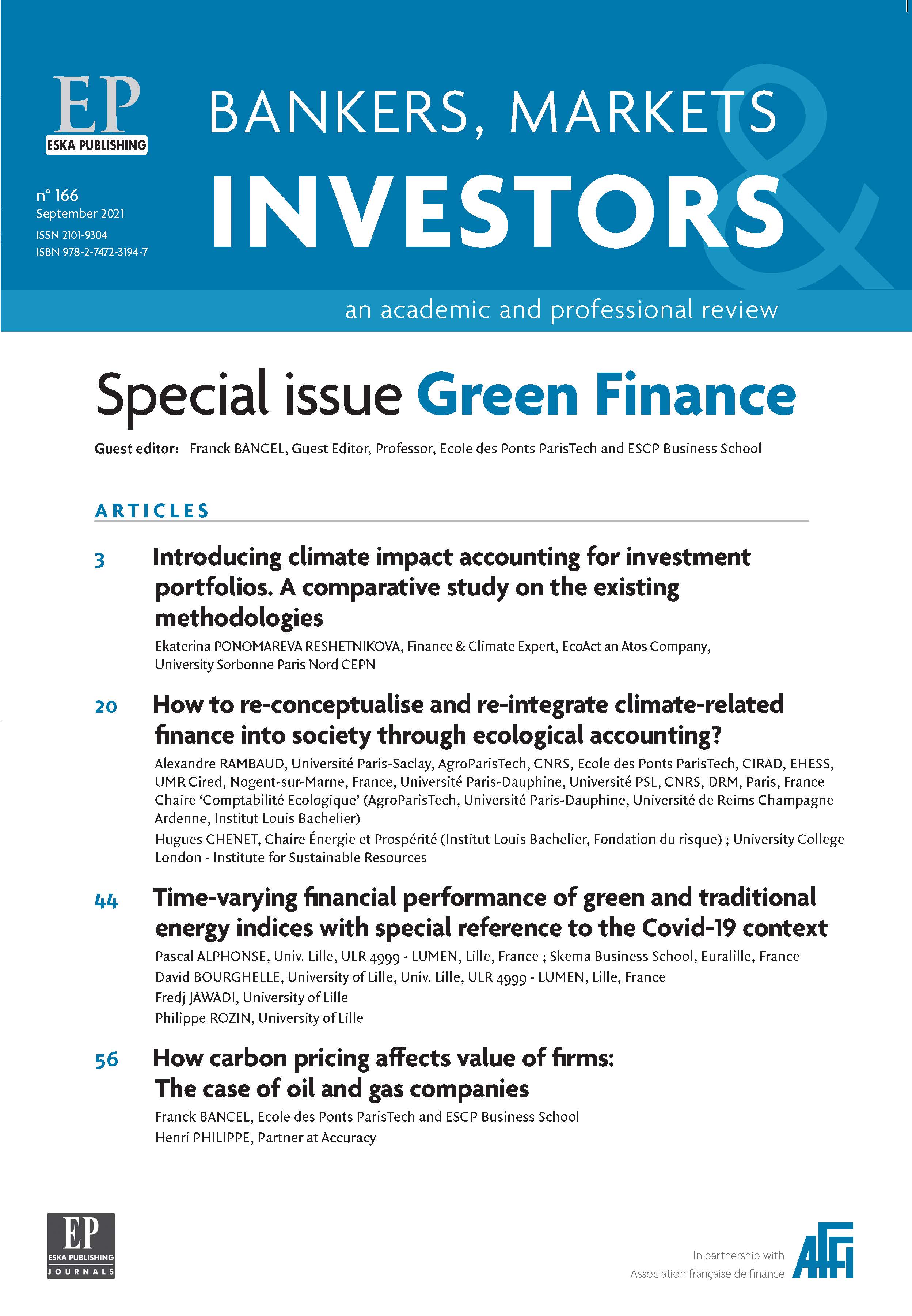TIME-VARYING FINANCIAL PERFORMANCE OF GREEN AND TRADITIONAL ENERGY INDICES WITH SPECIAL REFERENCE TO THE COVID-19 CONTEXT
DOI:
https://doi.org/10.54695/bmi.166.6714Keywords:
market beta, financial performance, green finance, nonlinearity, Covid-19Abstract
This paper comparatively investigates the financial performance of traditional and green energy indices from 2010 up to the current context of Covid-19. In particular, we analyze whether the green finance index supplants the traditional class of energy indices and examine whether consideration of a green index could provide a useful hedging solution in the specific context of Covid-19, a situation marked by a significant health risk and high volatility in the energy sector. Accordingly, we estimate different performance ratios and present some interesting findings. In particular, we find evidence of volatility and time variation in the market beta, suggesting that, whether conventional or green, energy sector sensitivity in fact depends on the market state (bear versus bull). Further, financial performance appears to be time varying and regime-dependent. Indeed, the conventional energy sector outperforms in a bear market, while the green index shows stronger financial performance in a bull market. These results are of interest for both investors and portfolio managers, helping them to balance their investments and optimize their portfolios according to the state of the market or the price regime.
References
Adamo, R., Federico, D., & Notte, A. (2014).
Performance and risk of green funds. Investment
management and financial innovations, (11, Iss. 1 (contin.)),
-145.
■ Albuquerque, Rui A. and Koskinen, Yrjo J
and Yang, Shuai and Zhang, Chendi, Love in
the Time of COVID-19: The Resiliency of Environmental
and Social Stocks (April 2020). CEPR Discussion Paper No.
DP14661, https://ssrn.com/abstract=3594293.
■ Bai, J. and P. Perron (2003a), “Computation and
Analysis of Multiple Structural Change Models”, Journal
of Applied Econometrics, (18), 1–22.
■ Bai, J. and P. Perron (2003b), “Critical Values for
Multiple Structural Change Tests”, Econometrics Journal,
(1), 1–7.
■ Bolton, P., & Kacperczyk, M. (2020). Do investors
care about carbon risk? (No. w26968). National Bureau of
Economic Research.
■ Chang, C. E., Nelson, W. A., & Witte, H. D. (2012).
Do green mutual funds perform well?. Management Research
Review.
■ Garel, A., Petit-Romec, A. (2020). Investor Rewards
to Environmental Responsibility in the COVID-19
Crisis. Available at SSRN 3620109.
■ Graham, J. R., & Harvey, C. R. (2001). Expectations
of equity risk premia, volatility and asymmetry from a
corporate finance perspective (No. w8678). National Bureau
of Economic Research.
■ Granger, C. W. J., & Teräsvirta, T. (1993). Modelling
Dynamic Non-linear Relationships. Oxford University Press.
■ Friede, G. Busch, T. and Bassen, A. (2015). ESG
and financial performance: aggregated evidence from
more than 2000 empirical studies. Journal of Sustainable
Finance & Investment, 5(4):210-233.
■ Hansen, B. E. (1996). Inference when a nuisance
parameter is not identified under the null hypothesis.
Econometrica: Journal of the econometric society, 413-430.
■ Lebelle, M., Lajili Jarjir, S., & Sassi, S. (2020).
Corporate Green Bond Issuances: An International
Evidence. Journal of Risk and Financial Management, 13(2), 25.
■ Liaw, K. T. (2020). Survey of Green Bond Pricing and
Investment Performance. Journal of Risk and Financial
Management, 13(9), 193.
■ Lim, K. S., & Tong, H. (1980). Threshold autoregressions,
limit cycles, and data. Journal of the Royal Statistical Sociaty,
B, 42, 245-92.
■ Modigliani, F., (1997). “Risk-Adjusted Performance”.
Journal of Portfolio Management. 1997 (Winter): 45–54.
■ Modigliani, Leah (1997). “Yes, You Can Eat Risk-
Adjusted Returns”. Morgan Stanley U.S. Investment
Research. 1997 (March 17, 1997): 1–4.
■ Nanayakkara, M., & Colombage, S. (2019). Do
investors in Green Bond market pay a premium? Global
evidence. Applied Economics, 51(40), 4425-4437.
■ Pham, L. (2016). Is it risky to go green? A volatility analysis
of the green bond market. Journal of Sustainable Finance &
Investment, 6(4), 263-291.
■ Ramiah, V., Martin, B., & Moosa, I. (2013). How
does the stock market react to the announcement of green
policies?. Journal of Banking & Finance, 37(5), 1747-1758.
■ Reboredo, J. C., & Ugolini, A. (2020). Price
connectedness between green bond and financial markets.
Economic Modelling, 88, 25-38.
■ Sharpe, W. F. (1964). Capital asset prices: A theory of
market equilibrium under conditions of risk. The journal
of finance, 19(3), 425-442
■ Terasvirta, T., Anderson, H. M. (1992)
Characterizing Nonlinearities in Business Cycles Using
¨ Smooth Transition Autoregressive Models. Journal of
Applied Econometrics 7: S119–S136.
■ Terasvirta, T. (1994) Specification, Estimation and
Evaluation of Smooth Transition Autoregressive Models.
Journal of the American Statistical Association 89: 208–21
■ Tong, H. and Lim, K. S. (1980) Threshold autoregression,
limit cycles and cyclical data (with discussion). Journal of
the Royal Statistical Society: Series B, 42, 245–292
■ Treynor, J.L. (1965) How to Rate Management of
Investment Funds. Harvard Business Review, 43, 63-75.
■ Tsay, R. (1989) Testing and Modelling Threshold
Autoregressive Processes. Journal of the American Statistical
Association 84: 231–240
■ Van Dijk, D., Franses, P. H., Lucas, A. (1998) Testing
for Smooth Transition Nonlinearity in the Presence of
Additive Outliers. Journal of Business and Economic Statistics
(2): 217–235
■ White, H. (1984) Asymptotic Theory for Econometricians.
Academic Press, London and San Diego
■ Zerbib, O. D. (2019). The effect of pro-environmental
preferences on bond prices: Evidence from green bonds.
Journal of Banking & Finance, 98, 39-60.




